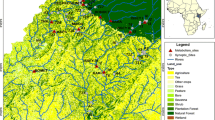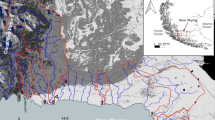Abstract
Managed flow releases are increasingly being utilised in the rehabilitation of regulated rivers to improve physical habitat condition and restore spatial connectivity. However, the potential for managed flow releases to influence basal resource availability to the downstream food web has received less attention. This study investigated dissolved organic carbon (DOC) delivery from managed flow releases from Jindabyne Dam and a regulated tributary to the Snowy River; a mixed rainfall-snowmelt river in south-east Australia. DOC concentration and load were monitored downstream of Jindabyne Dam during two high-flow dam releases and 2 month-long tributary releases provided by temporarily suspending tributary weir diversions. DOC chemical composition in the downstream Snowy River was characterised using fluorescence spectrophotometry. A negligible change or decrease in DOC concentration occurred at all monitored sites during both dam releases. In contrast, pulsed increases in DOC concentration concomitant with natural high-flow events were observed in the Snowy River during the tributary releases. The estimated DOC load delivered by the larger dam release increased 1.5-fold between sites 2 and 22 km downstream of the Jindabyne Dam. Reservoir release waters contained both humic-like and protein-like DOC fluorophores, whereas tributary releases contained only humic-like DOC fluorophores. Collectively, these results suggest that changes in DOC quantity and composition during managed dam releases reflect localised wetting and DOC mobilisation from the riparian zone whilst tributary releases deliver storm-associated pulses of terrestrial DOC flushed from the catchment. The unique DOC regimes associated with dam and tributary-sourced water releases may influence ecosystem functioning in the downstream river.








Similar content being viewed by others
References
Ahearn DS, Sheibley RW, Dahlgren RA (2005) Effects of river regulation on water quality in the lower Mokelumne River, California. River Res Appl 21:651–670. doi:10.1002/rra.853
Arthington AH, Pusey BJ (2003) Flow restoration and protection in Australian rivers. River Res Appl 19:377–395. doi:10.1002/rra.745
Baker A, Inverarity R (2004) Protein-like fluorescence intensity as a possible tool for determining river water quality. Hydrol Process 18:2927–2945. doi:10.1002/hyp.5597
Bernhardt ES, Likens GE (2002) Dissolved organic carbon enrichment alters nitrogen dynamics in a forest stream. Ecology 83:1689–1700. doi:10.2307/3071988
Boyer EW, Hornberger GM, Bencala KE, McKnight DM (1997) Response characteristics of DOC flushing in an alpine catchment. Hydrol Process 11:1635–1647
Buffam I, Galloway JN, Blum LK, McGlathery KJ (2001) A stormflow/baseflow comparison of dissolved organic matter concentrations and bioavailability in an Appalachian stream. Biogeochemistry 53:269–306
Bunn SE, Arthington AH (2002) Basic principles and ecological consequences of altered flow regimes for aquatic biodiversity. Environ Manage 30:492–507. doi:10.1007/s00267-002-2737-0
Chester H, Norris R (2006) Dams and flow in the Cotter River, Australia: effects on instream trophic structure and benthic metabolism. Hydrobiologia 572:275–286. doi:10.1007/s10750-006-0219-8
Coble PG (1996) Characterization of marine and terrestrial DOM in seawater using excitation-emission matrix spectroscopy. Mar Chem 51:325–346. doi:10.1016/0304-4203(95)00062-3
Cooper DM, Watts CD (2002) A comparison of river load estimation techniques: application to dissolved organic carbon. Environmetrics 13:733–750. doi:10.1002/env.525
Cory RM, Kaplan LA (2012) Biological lability of streamwater fluorescent dissolved organic matter. Limnol Oceanogr 57:1347–1360. doi:10.4319/lo.2012.57.5.1347
Cross WF et al (2011) Ecosystem ecology meets adaptive management: food web response to a controlled flood on the Colorado River, Glen Canyon. Ecol Appl 21:2016–2033. doi:10.1890/10-1719.1
Davie AW, Mitrovic SM (2014) Benthic algal biomass and assemblage changes following environmental flow releases and unregulated tributary flows downstream of a major storage. Mar Freshw Res 65:1059–1071. doi:10.1071/mf13225
Eaton AD, Franson MH (2005) Standard methods for the examination of water & wastewater. American Public Health Association, Washington, D.C.
Erskine WD, Terrazzolo N, Warner RF (1999) River rehabilitation from the hydrogeomorphic impacts of a large hydro-electric power project: Snowy River, Australia. Regul Rivers Res Manag 15:3–24. doi:10.1111/1467-8470.00091
Fellman JB, Hood E, Spencer RGM (2010) Fluorescence spectroscopy opens new windows into dissolved organic matter dynamics in freshwater ecosystems: a review. Limnol Oceanogr 55:2452–2462. doi:10.4319/lo.2010.55.6.2452
Findlay S, Sinsabaugh RL (1999) Unravelling the sources and bioavailability of dissolved organic matter in lotic aquatic ecosystems. Mar Freshw Res 50:781–790
Findlay SEG, Sinsabaugh RL, Sobczak WV, Hoostal M (2003) Metabolic and structural response of hyporheic microbial communities to variations in supply of dissolved organic matter. Limnol Oceanogr 48:1608–1617
Goodman KJ, Baker MA, Wurtsbaugh WA (2011) Lakes as buffers of stream dissolved organic matter (DOM) variability: temporal patterns of DOM characteristics in mountain stream-lake systems. J Geophys Res Biogeosci 116:15. doi:10.1029/2011JG001709
Growns I, Reinfelds I (2014) Environmental flow management using transparency and translucency rules. Mar Freshw Res 65:667–673. doi:10.1071/MF13192
Hall RO, Meyer JL (1998) The trophic significance of bacteria in a detritus-based stream food web. Ecology 79:1995–2012. doi:10.2307/176704
Henson SS, Ahearn DS, Dahlgren RA, Van Nieuwenhuyse E, Tate KW, Fleenor WE (2007) Water quality response to a pulsed-flow event on the Mokelumne River, California. River Res Appl 23:185–200. doi:10.1002/rra.973
Hinton MJ, Schiff SL, English MC (1997) The significance of storms for the concentration and export of dissolved organic carbon from two Precambrian Shield catchments. Biogeochemistry 36:67–88. doi:10.1023/a:1005779711821
Hornberger GM, Bencala KE, McKnight DM (1994) Hydrological controls on dissolved organic carbon during snowmelt in the Snake River near Montezuma, Colorado. Biogeochemistry 25:147–165
Kelly HAW, Rosi-Marshall EJ, Kennedy TA, Hall RO Jr, Cross WF, Baxter CV (2013) Macroinvertebrate diets reflect tributary inputs and turbidity-driven changes in food availability in the Colorado River downstream of Glen Canyon Dam. Freshw Sci 32:397–410. doi:10.1899/12-088.1
King J, Louw D (1998) Instream flow assessments for regulated rivers in South Africa using the Building Block Methodology. Aquat Ecosyst Health Manage 1:109–124. doi:10.1016/S1463-4988(98)00018-9
King AJ, Ward KA, O’Connor P, Green D, Tonkin Z, Mahoney J (2010) Adaptive management of an environmental watering event to enhance native fish spawning and recruitment. Freshw Biol 55:17–31. doi:10.1111/j.1365-2427.2009.02178.x
Konrad CP et al (2011) Large-scale flow experiments for managing river systems. Bioscience 61:948–959. doi:10.1525/bio.2011.61.12.5
Kothawala DN, Murphy KR, Stedmon CA, Weyhenmeyer GA, Tranvik LJ (2013) Inner filter correction of dissolved organic matter fluorescence. Limnol Oceanogr Methods 11:616–630. doi:10.4319/lom.2013.11.616
Larson JH, Frost PC, Zheng ZY, Johnston CA, Bridgham SD, Lodge DM, Lamberti GA (2007) Effects of upstream lakes on dissolved organic matter in streams. Limnol Oceanogr 52:60–69
Lawaetz AJ, Stedmon CA (2009) Fluorescence intensity calibration using the Raman scatter peak of water. Appl Spectrosc 63:936–940
Lennon JT, Cottingham KL (2008) Microbial productivity in variable resource environments. Ecology 89:1001–1014
McClain ME et al (2003) Biogeochemical hot spots and hot moments at the interface of terrestrial and aquatic ecosystems. Ecosystems 6:301–312. doi:10.1007/s10021-003-0161-9
McKnight DM, Smith RL, Harnish RA, Miller CL, Bencala KE (1993) Seasonal relationships between planktonic microorganisms and dissolved organic material in an alpine stream. Biogeochemistry 21:39–59. doi:10.1007/bf00002687
Meyer JL (1994) The microbial loop in flowing waters. Microb Ecol 28:195–199
Miller MP (2012) The influence of reservoirs, climate, land use and hydrologic conditions on loads and chemical quality of dissolved organic carbon in the Colorado River. Water Resour Res 48:15. doi:10.1029/2012wr012312
Minor E, Stephens B (2008) Dissolved organic matter characteristics within the Lake Superior watershed. Org Geochem 39:1489–1501. doi:10.1016/j.orggeochem.2008.08.001
Moran MA, Covert JS (2003) Photochemically mediated linkages between dissolved organic matter and bacterioplankton. In: Findlay S, Sinsabaugh RL (eds) Interactivity of dissolved organic matter. Elsevier, Oxford, pp 244–259
Nguyen ML, Westerhoff P, Baker L, Hu Q, Esparza-Soto M, Sommerfeld M (2005) Characteristics and reactivity of algae-produced dissolved organic carbon. J Environ Eng ASCE 131:1574–1582. doi:10.1061/(asce)0733-9372(2005)131:11(1574)
Nguyen HVM, Hur J, Shin HS (2010) Changes in spectroscopic and molecular weight characteristics of dissolved organic matter in a river during a storm event. Water Air Soil Pollut 212:395–406. doi:10.1007/s11270-010-0353-9
Patten DT, Harpman DA, Voita MI, Randle TJ (2001) A managed flood on the Colorado River: background, objectives, design, and implementation. Ecol Appl 11:635–643
Poff NL, Zimmerman JKH (2010) Ecological responses to altered flow regimes: a literature review to inform the science and management of environmental flows. Freshw Biol 55:194–205. doi:10.1111/j.1365-2427.2009.02272.x
Poff NL et al (1997) The natural flow regime. Bioscience 47:769–784
Reinfelds I, Williams S, Russell M, Haeusler T (2013) Scaling environmental flow releases in the Snowy River to unregulated snowmelt rivers of the Snowy Mountains. NSW Office of Water, Sydney
Robinson CT, Uehlinger U (2008) Experimental floods cause ecosystem regime shift in a regulated river. Ecol Appl 18:511–526
Rohlfs A, Mitrovic SM, WIlliams S, Coleman D (2015) Can tributary in-flows improve DOC regime recovery in a snowmelt river regulated by a large reservoir? Mar Freshw Res. doi:10.1071/MF14230
Sanderman J, Lohse KA, Baldock JA, Amundson R (2009) Linking soils and streams: Sources and chemistry of dissolved organic matter in a small coastal watershed. Water Resour Res. doi:10.1029/2008wr006977
Schindler J, Krabbenhoft D (1998) The hyporheic zone as a source of dissolved organic carbon and carbon gases to a temperate forested stream. Biogeochemistry 43:157–174. doi:10.1023/A:1006005311257
Stedmon CA, Cory RM (2014) Biological origins and fate of fluorescent dissolved organic matter in aquatic environments. In: Coble PG, Lead J, Baker A (eds) Aquatic organic matter fluorescence. Cambridge University Press, New York
Stedmon CA, Markager S (2005) Tracing the production and degradation of autochthonous fractions of dissolved organic matter by fluorescence analysis. Limnol Oceanogr 50:1415–1426
Tank JL, Rosi-Marshall EJ, Griffiths NA, Entrekin SA, Stephen ML (2010) A review of allochthonous organic matter dynamics and metabolism in streams. J N Am Benthol Soc 29:118–146. doi:10.1899/08-170.1
Uehlinger U, Kawecka B, Robinson CT (2003) Effects of experimental floods on periphyton and stream metabolism below a high dam in the Swiss Alps (River Spol). Aquat Sci 65:199–209. doi:10.1007/s00027-003-0664-7
Ulseth AJ, Hall RO Jr (2015) Dam tailwaters compound the effects of reservoirs on the longitudinal transport of organic carbon in an arid river. Biogeosciences 12:4345–4359. doi:10.5194/bg-12-4345-2015
Ward JV, Stanford JA (1983) The serial discontinuity concept of lotic ecosystems. In: Fontaine TD, Bartell SM (eds) Dynamics of lotic ecosystems. Ann Arbor Scienec Publishers, Michigan, pp 29–42
Wilcox HS, Wallace JB, Meyer JL, Benstead JP (2005) Effects of labile carbon addition on a headwater stream food web. Limnol Oceanogr 50:1300–1312
Young RG, Matthaei CD, Townsend CR (2008) Organic matter breakdown and ecosystem metabolism: functional indicators for assessing river ecosystem health. J N Am Benthol Soc 27:605–625. doi:10.1899/07-121.1
Acknowledgments
This work was funded by the NSW DPI Water Snowy Flow Response Monitoring and Modelling Program and Snowy Hydro Ltd. We thank Dr John Brayan and staff at the NSW DPI Water laboratory for water sample analysis; Dr Christian Evenhuis for valuable advice regarding statistical analysis; and Daniel Coleman, Tim Haeusler, Matt Russell, Shane Mogg, Jason Venables, Sam Wyper, Jason Snape and Jessie O’Brien for field assistance. Thanks to Dr Stuart Findlay and two anonymous reviewers for their comments which greatly improved the manuscript.
Author information
Authors and Affiliations
Corresponding author
Rights and permissions
About this article
Cite this article
Rohlfs, AM., Mitrovic, S.M., Williams, S. et al. Dissolved organic carbon delivery from managed flow releases in a montane snowmelt river. Aquat Sci 78, 793–807 (2016). https://doi.org/10.1007/s00027-016-0472-5
Received:
Accepted:
Published:
Issue Date:
DOI: https://doi.org/10.1007/s00027-016-0472-5




